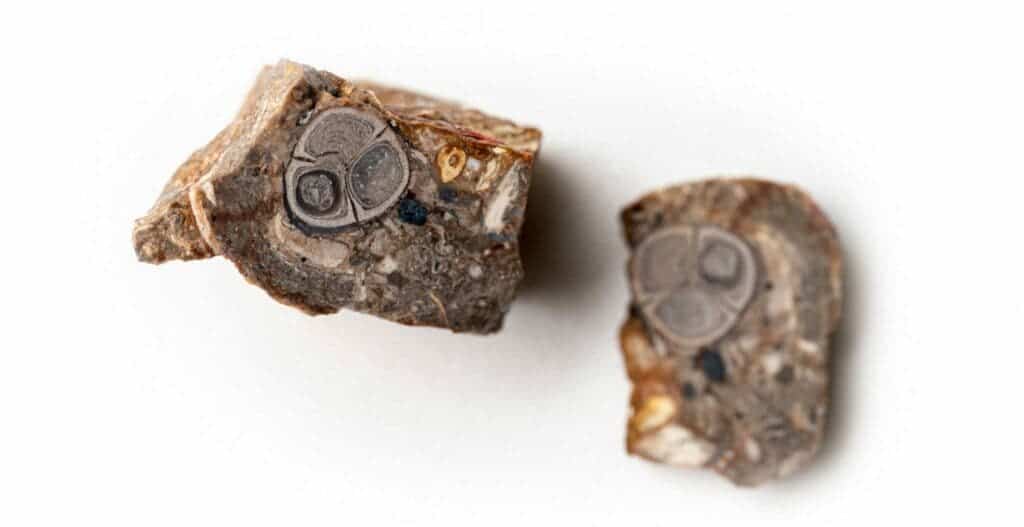An international team of researchers from the Rashtrasant Tukadoji Maharaj Nagpur University, India, and the Florida Museum of Natural History describes a new fossil species of fruit from specimens discovered in Indian chert.

The Deccan Traps of India form one of the largest volcanic features on Earth today. They were formed by a series of giant volcanic eruptions between 66 and 65 million years ago. Although precise dating of these eruptions is difficult due to several factors, it is believed that they occurred over a period of 30,000 years during the stated time frame. These eruptions covered an area of almost 500,000 square kilometers in several layers of basalt rocks, in some places stacking to over 2 kilometers in depth. The “trap” in the name is a geological term that refers to dark-colored, fine-grained, non-granitic magmatic rock — in this case, layers upon layers of basalt flows.
Despite the violent conditions in which this structure was born, today the Deccan Traps are one of the richest fossil-bearing areas in the world. A new species of extinct plant, described from fossilized fruit specimens unearthed in the area, adds to the rich list of discoveries made in the Deccan Traps.
Explosive fruit
Shales, chert, limestone, and clay bodies are contained in alternating bands between the area’s basalt flows, and they are rich in fossilized plants and animals. These layers capture a snapshot of the calm periods, and the ecosystems that formed, between eruptions.
The newly-described species was most likely a shrub or small tree growing around hot springs in the area (an ecosystem that resembles those in today’s Yellowstone National Park). At the time when the present specimen was fossilized, India was passing through the Equatorial zone; the humid, warm conditions at the time allowed for several tropical species including bananas, aquatic ferns, mallows and relatives of modern crepe myrtles to thrive on its lands. One puzzling discovery from this time is that, although petrified wood is common in the Deccan Traps, most of the examples found had small diameters, which points to a lack of large trees — a surprising fact for a tropical region.
“India was positioned at a low latitude, so we’d expect to find big forest giants. But that’s not what we’re seeing,” says senior author Steven Manchester, a paleobotanist at the Florida Museum of Natural History.
Manchester suspects that the basalt layers covering the region prevented the development of deep roots, which in turn restricted the maximum growth of trees in the area. Another possible explanation that he is considering is that, since the area was very volcanically active, forests were routinely wiped out by lava flows, so the trees here simply didn’t have enough time to grow. Although bad for the trees, these events did create a lot of volcanic ash, which helped to fossilize plant material in the area.
The fossilized fruit described in this study was found preserved in a body of chert, silica-rich rocks, by co-author Dashrath Kapgate. Lava is rich in silica, so it’s a real possibility that the active volcanism in the area at this time helped create the conditions necessary for it to fossilize.
The researchers explain that the fruit “didn’t really fit well into any known plant group”. They took a large quantity of CT scans of the fossil as well as fruits from extant species to allow for direct comparison. Ultimately, similarities with fruit specimens provided by the Smithsonian Institution led the team to conclude that the fossil belonged to a member of the spurge family (Euphorbiaceae). Because it was so different from any existing plant, however, they classified it as an entirely new species, deccanensis, of the fossil genus Euphorbiotheca.
Based on the orientation of the fibers inside the fruit, the team is confident that they were meant to disperse their seed by exploding when ripe — a common mechanism in other plants in their genus. After explosive fruits ripen, they dry out significantly– losing as much ast 64% of their original weight — which builds up a lot of tension in the rigid outer layers. At a point, this leads to the fruits breaking apart, with the stored tension sending seeds flying everywhere.
“You hear this loud pop, and the seeds and pieces of the fruit go flying everywhere,” Manchester said, describing the process in rubber trees. “We think this is the case for these two fossil species as well, because we see the same anatomy, where the fibers in the inner and outer layers of the fruit wall are oriented in opposing directions, which helps build torque.”
The team hopes that their discovery will help us piece together the distribution of species during a critical time in Earth’s history. At the time this fruit fossilized, India and Madagascar had already broken away from the supercontinent Gondwana and were moving north towards modern Eurasia. Life here evolved in isolation throughout the Cretaceous, leading to unique species including (it is believed) modern grapes and the ancestors of whales. When India finally did collide with Asia, these plant species were given the opportunity to spread across the new land, populating today’s Europe and Asia.
The paper “Fruits of Euphorbiaceae from the Late Cretaceous Deccan Intertrappean Beds of India” has been published in the International Journal of Plant Sciences.









